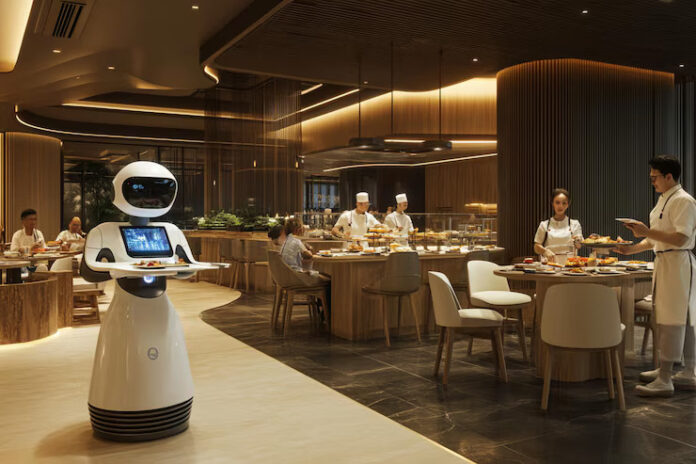1. Introduction: Hospitality Enters the Smart Era
- The guest experience is no longer just about luxury—it’s about intelligence, personalization, and seamlessness.
- AI and automation are quietly transforming the very bones of interior design in hotels, resorts, and short-term rentals.
2. Smart Rooms: The New Gold Standard
🤖 AI-Powered Personalization
- Lighting, temperature, curtains, and entertainment preferences adjust based on guest profiles or past behavior.
- Rooms use machine learning to adapt to time of day, season, or mood.
🎛️ Interior Implications:
- Hidden sensors, smart panels, and modular design to accommodate changing layouts and features.
- Ambient lighting schemes and multi-layered material palettes that interact with smart controls.
3. Automation Behind the Scenes
🧺 Housekeeping & Facility Management
- Predictive AI triggers cleaning, restocking, or repairs based on usage data.
- Robotic assistants handle linen delivery or concierge services.
📐 Design Shift:
- Creation of service corridors and back-end tech zones that are out of sight but integral.
- Discreet integration of charging docks, hidden passageways, and robot-friendly navigation paths.
4. Touchless Everything: Post-Pandemic Priorities
🛎️ From Check-In to Check-Out
- Voice-activated elevators, gesture-based lighting, mobile key cards, facial recognition access.
- AI kiosks or digital concierges reduce human contact and streamline processes.
🚪 Design Evolution:
- Lobby areas are becoming leaner but more tech-driven, with interactive walls and minimal touchpoints.
- Reception desks are replaced or downsized in favor of open, lounge-like layouts.
5. Experience Zones Powered by AI
🎨 Immersive & Adaptive Spaces
- Dynamic art installations that change based on guest mood or local events.
- AI-curated playlists, scent diffusers, or projection mapping tailored to seasons or themes.
📏 Interior Strategy:
- Use of flexible digital surfaces, curved walls for projections, and mood-responsive lighting setups.
- Integration of tech within decor—mirrors that become screens, walls that double as info boards.
6. Sustainability Meets Intelligence
- Smart energy systems reduce waste by analyzing guest behavior.
- AI-powered HVAC, lighting, and water-saving fixtures.
🌿 Interior Focus:
- Use of eco-friendly materials paired with smart usage tracking.
- Dashboards in rooms to show guests their environmental impact in real-time.
7. Challenges & Considerations
- Privacy and data security: Where do design and data ethics intersect?
- Not all guests are tech-savvy—interiors must balance high-tech with intuitive, human-centric design.
- Durability: Designing for fast-changing tech cycles without needing constant overhaul.
Conclusion: The New Face of Hospitality is Invisible
AI and automation aren’t just conveniences—they’re reshaping how hospitality interior design spaces look, feel, and function. Interior designers are now not just decorators—they’re experience architects, crafting responsive environments for the travelers of tomorrow. Read the details on Design arc interiors.


